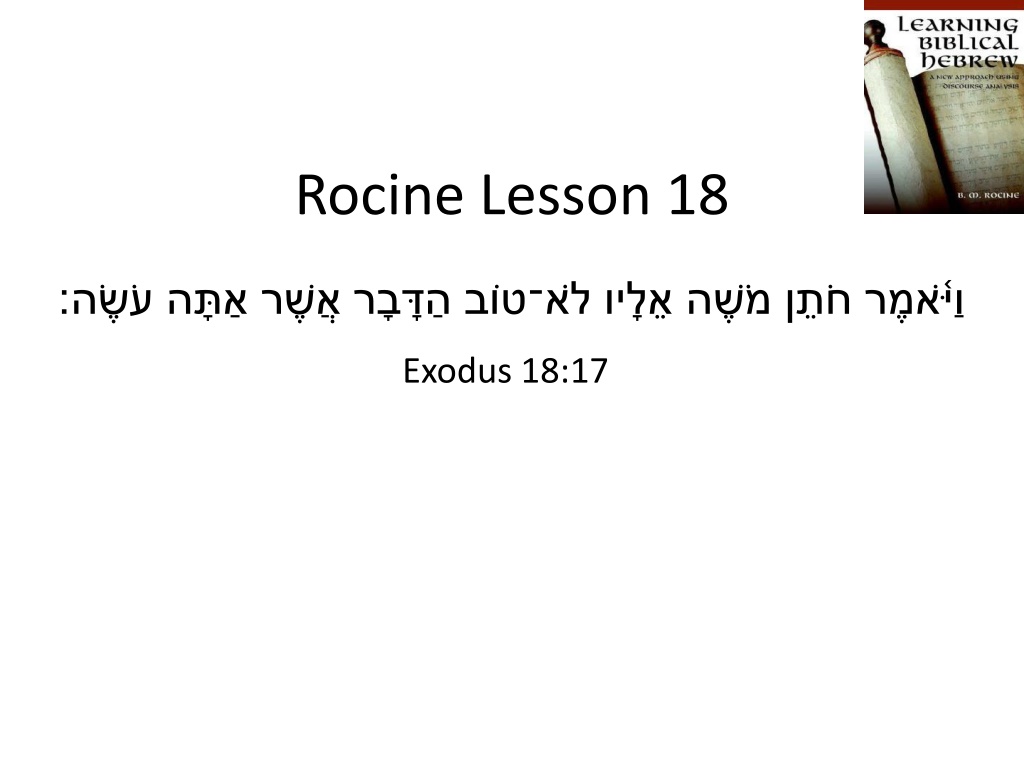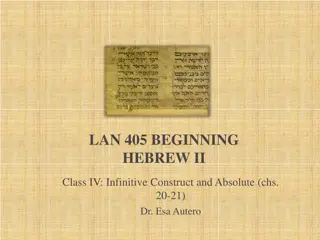Understanding Hebrew Adjectives: Function and Usage Explained
Explore the functionality and usage of Hebrew adjectives as they can function in three ways - attributive, predicate, and substantive. Learn how they describe nouns, verbs, and function on their own in Hebrew language.
Download Presentation

Please find below an Image/Link to download the presentation.
The content on the website is provided AS IS for your information and personal use only. It may not be sold, licensed, or shared on other websites without obtaining consent from the author. Download presentation by click this link. If you encounter any issues during the download, it is possible that the publisher has removed the file from their server.
E N D
Presentation Transcript
Rocine Lesson 18 Exodus 18:17
Goals Identify and read adjectives independent subject pronouns the most common irregular nouns
What you already know Try reading the lesson verse. means (father) in-law means good One challenge is to decide where the direct speech begins. The definiteness of indicates it is the subject of its clause (see Rocine 6.4a)
Grammer review What is a noun?
Grammer review What is a pronoun?
Grammer review What is a verb?
Grammer review What is an adjective?
Grammer review What is an adverb?
Adjectives What do Hebrew Adjectives look like? NOUNS Singular Plural Masc Fem See AnimatedHebrew lecture 7 ADJECTIVES Singular Plural Masc Fem See AnimatedHebrew lecture 9
Adjectives Now we re going to look more closely at how Hebrew Adjectives function. What do they do? How should translate them?
Adjectives Hebrew Adjectives can function in 3 ways. Like an adjective. Attributive Like a verb. Predicate Substantive Like a noun.
Adjectives Hebrew Adjectives can function in 3 ways. Like an adjective. What we normally think of as an adjective, i.e. a word that describes a noun. The red football jersey. Attributive Like a verb. Predicate Substantive Like a noun.
Adjectives Hebrew Adjectives can function in 3 ways. Like an adjective. What we normally think of as an adjective, i.e. a word that describes a noun. The red football jersey. Attributive Like a verb. Occurs in a verbless clause. The adjective describes the subject of the sentence with the verb to be. Red is the football jersey. Predicate Substantive Like a noun.
Adjectives Hebrew Adjectives can function in 3 ways. Like an adjective. What we normally think of as an adjective, i.e. a word that describes a noun. The red football jersey. Attributive Like a verb. Occurs in a verbless clause. The adjective describes the subject of the sentence with the verb to be. Red is the football jersey. Predicate Substantive Like a noun. The adjective takes the place of a noun. The Reds are winning! Go Reds!!!
Suggestions for learning Adjectives 1. View Animated Hebrew lecture 9 Syntax of the Adjective Attributive (12:18) Syntax of the Adjective Predicate (11:05) Syntax of the Adjective Substantive (4:48) 2. Write down the rules for determining each type. 3. Look at Rocine s examples (Rocine 18.2a) Note that Rocine talks about 2 types of adjectives: predicate and attributive. He includes the substantive as a subset of the attributive (bottom of page 100), which is fine, but his example is actually wrong. It s an example of the attributive use not substantive.
Independent subject pronouns Singular Plural 3ms 3cp 3fs 2ms 2mp 2fs 2fp 1cs 1cp See AnimatedHebrew lecture 11
Independent subject pronouns Singular Plural 3ms 3cp 3fs 2ms 2mp 2fs 2fp 1cs 1cp See AnimatedHebrew lecture 11
Independent subject pronouns 3rd Person all start with Singular Plural 3ms 3cp 3fs 2ms 2mp 2fs 2fp 1cs 1cp 2nd and 1st Person all start with See AnimatedHebrew lecture 11
Independent subject pronouns 3rd Person all start with Singular Plural 3ms 3cp 3fs 2ms 2mp 2fs 2fp 1cs 1cp 2nd and 1st Person all start with See AnimatedHebrew lecture 11
Independent subject pronouns 3rd Person all start with Singular Plural 3ms 3cp 3fs 2ms 2mp 2rd Person all have 2fs 2fp 1cs 1cp 2nd and 1st Person all start with See AnimatedHebrew lecture 11
Independent subject pronouns 3rd Person all start with Singular Plural 3ms 3cp 3fs 2ms 2mp 2rd Person all have 2fs 2fp 1cs 1cp 2nd and 1st Person all start with See AnimatedHebrew lecture 11
Independent subject pronouns 3rd Person all start with Singular Plural 3ms 3cp 3fs 2ms 2mp 2rd Person all have 2fs 2fp 1st Person all have 1cs 1cp 2nd and 1st Person all start with See AnimatedHebrew lecture 11
Independent subject pronouns 3rd Person all start with Singular Plural 3ms 3cp 3fs 2ms 2mp 2rd Person all have What does mean? 2fs 2fp 1st Person all have 1cs 1cp 2nd and 1st Person all start with See AnimatedHebrew lecture 11
Irregular nouns Rocine gives a table of irregular noun forms on page 102 that he says to memorize. haha These are extremely common nouns but I wouldn t memorize them. Instead Have a look at the table, note it s location in the book so you can find it again and then come back to it when you encounter these forms in your reading.
Irregular nouns Table from Rocine 18, p. 102. Father Brother Sister Man Woman House Son Daughter Day City Name Singular Absolute Singular Construct Sing. + 2ms sfx Plural Absolute ---- Plural Construct ---- Plural + 2ms sfx ---- = my father = my fathers = my brother = my brothers = my house
Irregular nouns Table from Rocine 18, p. 102. Father Brother Sister Man Woman House Son Daughter Day City Name Singular Absolute Singular Construct Sing. + 2ms sfx Plural Absolute ---- Plural Construct ---- Plural + 2ms sfx ---- = my father = my fathers = my brother = my brothers = my house Note typos in Rocine. There are no dageshim in these letters.
Review - Discourse profile of Historical Narrative 1. Mainline: Wayyiqtol Off-the-line: 2. Topicalization: X-qatal 3. Relative past background: qatal 4. Transition marker: Wayyiqtol of 5. Scene setting: Verbless Clause 6. Irrealis scene setting: Negation of any verb by
Review - Discourse profile of Historical Narrative 1. Mainline: Wayyiqtol Skeleton or Framework Off-the-line: 2. Topicalization: X-qatal 3. Relative past background: qatal 4. Transition marker: Wayyiqtol of 5. Scene setting: Verbless Clause 6. Irrealis scene setting: Negation of any verb by Details: setting, summary, elaboration, etc.
Review - Discourse profile of Historical Narrative Advances the narrative 1. Mainline: Wayyiqtol Skeleton or Framework Off-the-line: 2. Topicalization: X-qatal 3. Relative past background: qatal 4. Transition marker: Wayyiqtol of 5. Scene setting: Verbless Clause 6. Irrealis scene setting: Negation of any verb by Details: setting, summary, elaboration, etc.
Review - Discourse profile of Historical Narrative Dynamic action Advances the narrative 1. Mainline: Wayyiqtol Skeleton or Framework Off-the-line: 2. Topicalization: X-qatal 3. Relative past background: qatal 4. Transition marker: Wayyiqtol of 5. Scene setting: Verbless Clause 6. Irrealis scene setting: Negation of any verb by Details: setting, summary, elaboration, etc.
Additions to the Discourse Profile 1. Mainline: Wayyiqtol Off-the-line: 2. Topicalization: X-qatal 3. Embedded Direct Speech 4. Relative past background: Qatal in dependent clause 5. Non-past background: Yiqtol in dependent clause 6. Backgrounded activities: Participle 7. Transition marker: Mainline form of 8. Scene setting: Verbless Clause 9. Irrealis scene setting: Negation of any verb Rocine 16 Genesis 22 reading Rocine 13.3 Rocine 12.2
Additions to the Discourse Profile Historical Narrative Predictive Narrative Instructional Discourse 1. Mainline: Wayyiqtol Weqatal Weqatal Off-the-line: 2. Topicalization: X-qatal 3. Embedded Direct Speech 4. Relative past background: Qatal in dependent clause 5. Non-past background: Yiqtol in dependent clause 6. Backgrounded activities: Participle 7. Transition marker: Mainline form of 8. Scene setting: Verbless Clause 9. Irrealis scene setting: Negation of any verb X-yiqtol X-yiqtol
Additions to the Discourse Profile Historical Narrative Predictive Narrative Instructional Discourse 1. Mainline: Wayyiqtol Weqatal Weqatal Off-the-line: 2. Topicalization: X-qatal 3. Embedded Direct Speech 4. Relative past background: Qatal in dependent clause 5. Non-past background: Yiqtol in dependent clause 6. Backgrounded activities: Participle 7. Transition marker: Mainline form of 8. Scene setting: Verbless Clause 9. Irrealis scene setting: Negation of any verb X-yiqtol X-yiqtol Fortunately for the student of Biblical Hebrew the discourse profile schemes for the different genres are different only at and near the mainline. The lower ranked constructions like dependent clauses, verbless clause, the participle, the forms, and irrealis have the same functions in almost all genres. (Rocine p. 103)























